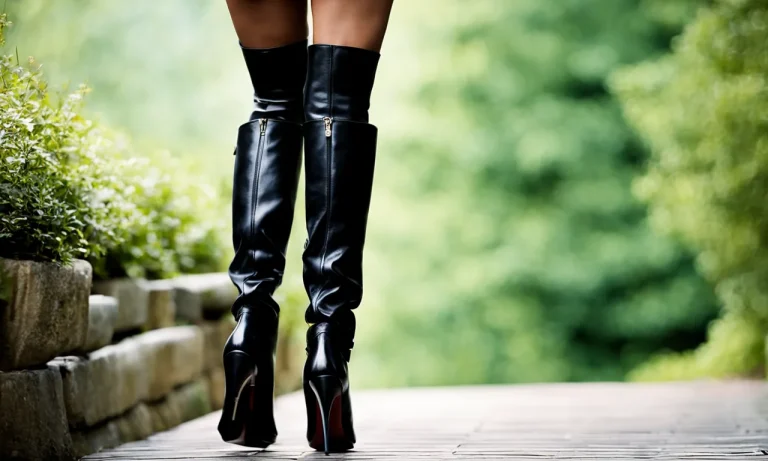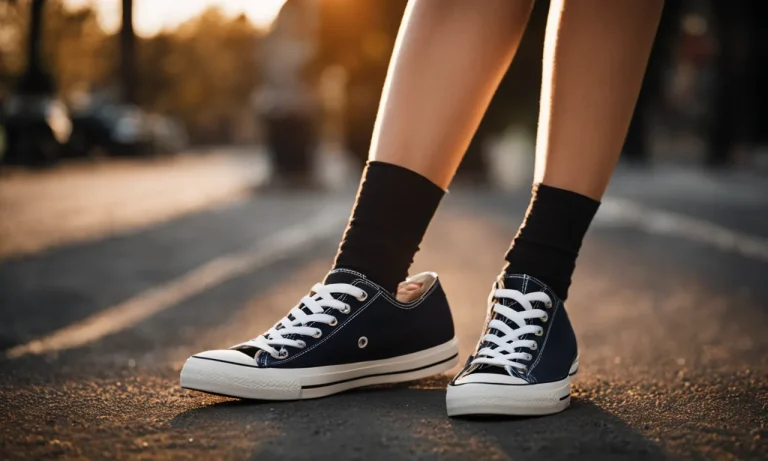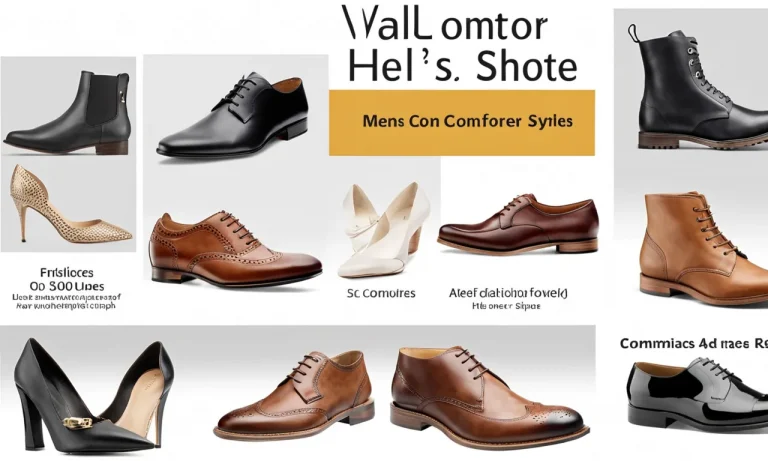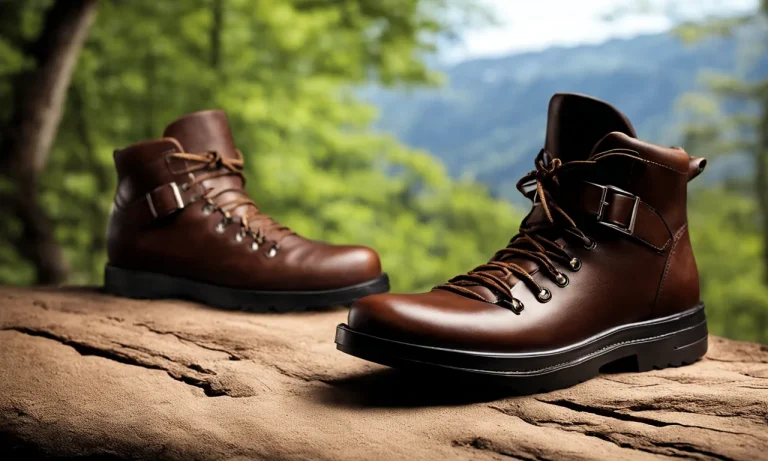If you’ve ever put on a brand new pair of leather shoes, you know how stiff and uncomfortable they can feel at first. The thick leather doesn’t bend and flex like it should, squeezing your feet and causing blisters.
But there’s good news – with a little time and effort, you can soften up any leather shoe to make it supple and comfortable to wear. In this comprehensive guide, we’ll go over everything you need to know to soften shoe leather effectively.
If you’re short on time, here’s a quick answer to softening leather shoes: Use a leather conditioner or oil, bend the shoes repeatedly to loosen them up, and apply heat from a hairdryer, heating pad or hot water. The combined effects will soften stiff leather in a few hours or days.
Why Do New Leather Shoes Need Softening?
When you first buy a pair of new leather shoes, you may notice that they can feel stiff and uncomfortable. This is because leather, while durable and stylish, is initially quite rigid. Softening leather shoes is an important step to make them more comfortable to wear and prevent potential blisters and discomfort.
Leather Production Process
Understanding the leather production process can shed light on why new shoes need softening. Leather is made from animal hides that undergo a complex tanning process to transform them into a durable material.
During tanning, the hides are treated with chemicals and undergo various mechanical processes to remove hair, fat, and other impurities. These processes can leave the leather stiff and inflexible.
Furthermore, leather is often treated with finishes and dyes to achieve the desired color and appearance. These finishes can also contribute to the stiffness of new leather shoes. Softening the leather will help to break down these finishes, making the shoes more pliable and comfortable.
Breaking in Stiff Soles
One common area of stiffness in new leather shoes is the soles. Stiff soles can make walking and movement difficult, causing discomfort and potentially leading to foot problems. Softening the soles of your shoes is essential for a more comfortable experience.
There are a few methods you can use to break in stiff soles. One popular method is to wear the shoes around the house with thick socks for short periods of time. This allows the leather to gradually mold to the shape of your feet and soften over time.
Another method is to use a leather softener or conditioner specifically designed for shoes. These products can help to soften the leather and make it more flexible.
It’s important to note that softening leather shoes is a gradual process. Rushing it may lead to damage or discomfort. Take your time and be patient as you break in your new leather shoes.
For more information on leather production and shoe care, you can visit leatherworkinggroup.com or shoe-care.org.
Materials and Tools Needed
Leather Conditioners and Oils
When it comes to softening shoe leather, using the right products is essential. One of the most effective ways to soften leather is by using leather conditioners and oils. These products are specially formulated to moisturize and nourish the leather, making it more supple and flexible.
Leather conditioners and oils can be easily found at shoe stores, online retailers, or even your local supermarket. Look for products that are specifically designed for leather shoes, as they will provide the best results.
Heat Sources
Heat can also be used to soften shoe leather, making it easier to stretch and mold. There are several heat sources that can be used for this purpose, such as a hairdryer, a heat gun, or even an oven. However, it’s important to use caution when applying heat to your shoes, as excessive heat can damage the leather.
Always follow the manufacturer’s instructions and start with a low heat setting to avoid any mishaps. Additionally, using a heat-resistant glove or a cloth to protect your hands is highly recommended.
Shoe Trees or Inserts
Another useful tool for softening shoe leather is a shoe tree or insert. These devices are designed to maintain the shape of your shoes and prevent them from shrinking or becoming misshapen. Shoe trees, which are usually made of wood or plastic, can be inserted into your shoes when they are not being worn.
This helps to stretch the leather and keep it pliable. Alternatively, you can use shoe inserts, which are specifically designed to soften and stretch tight areas of the shoe. These inserts are typically made of foam or gel and can be placed directly into the problem areas.
By using the right materials and tools, you can effectively soften shoe leather and make your shoes more comfortable to wear. Whether you choose to use leather conditioners and oils, heat sources, or shoe trees and inserts, be sure to follow the instructions carefully and take proper care of your shoes.
With a little effort, you’ll have soft, supple leather shoes that feel great on your feet!
Softening Methods
When it comes to softening shoe leather, there are several effective methods you can try. Each method has its own benefits and suitability for different types of leather. Here are some of the most popular and effective techniques:
Apply Leather Conditioner
One of the easiest and most common ways to soften shoe leather is by using a leather conditioner. Leather conditioners are specially formulated to moisturize and soften the leather, making it more flexible and comfortable to wear.
To use a leather conditioner, simply apply a small amount onto a clean cloth and gently rub it onto the surface of the leather. Allow the conditioner to penetrate the leather for a few minutes, then wipe off any excess with a clean cloth.
This method is particularly effective for dry or stiff leather.
Flex and Bend the Shoes
An effective way to soften shoe leather is by flexing and bending the shoes. This helps to break in the leather and make it more pliable. To do this, put on the shoes and gently flex your feet and toes, moving them in different directions.
You can also bend the shoes back and forth with your hands to loosen up the leather. This method is best for shoes that are slightly stiff or tight.
Use Focused Heat
Another method to soften shoe leather is by using focused heat. This can be done using a hairdryer or a heat gun set to a low or medium heat setting. Hold the heat source a few inches away from the leather and move it in a circular motion to evenly distribute the heat.
Be careful not to overheat the leather, as this can cause damage. After applying the heat, allow the shoes to cool down and then flex and bend them to further soften the leather. This method is ideal for breaking in new leather shoes.
Stuff Shoes Overnight
Stuffing your shoes overnight is a great way to soften the leather while maintaining their shape. You can use various materials to stuff the shoes, such as newspaper, tissue paper, or shoe trees. Fill the shoes with the chosen material and leave them overnight.
The pressure from the stuffing will help stretch and soften the leather. In the morning, remove the stuffing and try on your shoes. This method is effective for both new and old leather shoes.
Repeat as Needed
It’s important to note that softening shoe leather is not a one-time process. Depending on the condition of the leather and the desired level of softness, you may need to repeat the chosen method multiple times.
Be patient and gradually work on softening the leather until it reaches the desired level of comfort. Regular maintenance and conditioning can also help keep the leather soft and supple over time.
Remember, it’s always a good idea to check the manufacturer’s recommendations and test any method on a small, inconspicuous area of the shoe before applying it to the entire surface. This will help ensure that the method is suitable for your specific type of leather.
Tips and Precautions
Test Conditioners First
When it comes to softening shoe leather, it is important to choose the right conditioner. Before applying any conditioner to your shoes, it is recommended to test it on a small, inconspicuous area first.
This will help you determine if the conditioner is suitable for your specific type of leather and if it produces the desired effect. Additionally, testing the conditioner first can prevent any potential damage or discoloration to your shoes.
Don’t Overheat
While heat can be used to soften shoe leather, it is crucial to exercise caution. Excessive heat can cause the leather to become brittle and prone to cracking. It is best to use moderate heat sources, such as a hairdryer on a low setting, and to keep the heat source at a safe distance from the shoes.
This will ensure that the leather gradually softens without any damage.
Allow Drying Time
After applying a conditioner or using heat to soften the leather, it is important to allow your shoes to dry properly. Rushing the process can lead to unwanted consequences, such as mold or mildew growth. To prevent this, place your shoes in a well-ventilated area and allow them to air dry naturally.
Avoid direct sunlight or using artificial heat sources, as these can further damage the leather.
Use Cedar Shoe Trees
One effective way to maintain the softness and shape of your leather shoes is by using cedar shoe trees. These shoe trees not only help retain the shape of your shoes but also absorb moisture and odor.
By inserting cedar shoe trees into your shoes after wearing them, you can prevent the leather from becoming stiff and maintain their overall quality for a longer period of time.
Frequently Asked Questions
How long does it take to soften leather shoes?
The time it takes to soften leather shoes can vary depending on the type of leather and the method you use. Generally, it can take anywhere from a few hours to a few days for the leather to become noticeably softer.
It’s important to be patient and not rush the process, as forcing the leather to soften too quickly can cause it to become damaged or stretched.
Can I put leather shoes in the dryer?
No, it is not recommended to put leather shoes in the dryer. The heat and tumbling action of the dryer can cause the leather to shrink, become misshapen, or even crack. Instead, it is best to allow the shoes to air dry naturally after cleaning or treating them.
To speed up the drying process, you can stuff them with newspaper or use a shoe tree to help maintain their shape.
What household items can I use to soften leather?
There are several household items that can be used to soften leather. One popular method is to use a mixture of equal parts white vinegar and water. Simply dab a soft cloth into the solution and gently rub it onto the leather. Another option is to use a small amount of olive oil or coconut oil.
Apply a small amount to a clean cloth and massage it into the leather in circular motions. Be sure to test any household item on a small, inconspicuous area of the shoe first to ensure it doesn’t cause any discoloration or damage.
Pro tip: If you’re unsure about using household items on your leather shoes, it’s always a good idea to consult the manufacturer’s care instructions or seek advice from a professional shoe repair specialist.
Conclusion
In summary, you can transform stiff new leather shoes into soft, supple footwear with some simple conditioning and breaking in techniques. Using leather oils or conditioners, focused heat, and flexing the shoes helps accelerate the softening process that would otherwise take many wears to achieve.
With a few inexpensive tools and materials on hand, you can soften leather effectively and make your new shoes comfortable in no time. Just remember to have realistic expectations, take it slow, and avoid over-softening the leather.






